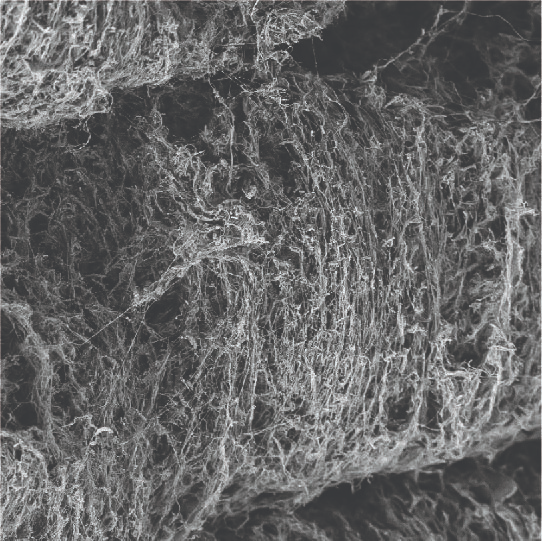Nov 11 2020
Researchers from Aalto University have used bacteria to create intricately developed three-dimensional objects made of nanocellulose. The new technique helps guide the growth of bacterial colonies by using highly water repellent, or superhydrophobic, surfaces.
 Unlike in conventional 3D printing, the fibers can be aligned in any direction, even across layers. Image Credit: Luiz Greca/Aalto University.
Unlike in conventional 3D printing, the fibers can be aligned in any direction, even across layers. Image Credit: Luiz Greca/Aalto University.
The objects exhibit huge potential for medical use, such as supporting tissue regeneration or as scaffolds to replace damaged organs. The findings of the study were reported in the ACS Nano journal.
In contrast to fibrous objects created using the existing 3D printing technique, the new technique enables fibers, with a diameter 1000 times less than a strand of human hair, to be aligned in any orientation, even over layers, and different gradients of thickness and topography. Therefore, the technique paves the way for new possibilities for application in tissue regeneration.
Such physical properties are vital for support materials in the growth and regeneration of specific kinds of tissues found in muscles and the brain.
It’s like having billions of tiny 3D printers that fit inside a bottle. We can think of the bacteria as natural microrobots that take the building blocks provided to them and, with the right input, create complex shapes and structures.
Luiz Greca, Doctoral Student, Aalto University
When the aerobic bacteria are placed in a superhydrophobic mold with water and nutrients such as proteins, sugar, and air, they synthesize nanocellulose. The superhydrophobic surface typically traps a thin layer of air, inducing the bacteria to produce a fibrous biofilm that replicates the shape and surface of the mold. The biofilm grows thicker with time and the objects thus turn stronger.
The team has used the technique to develop 3D objects with pre-designed features that measure one-tenth of the diameter of a single strand of hair up to 15–20 cm. When placed in contact with human tissues, the nano-sized fibers do not lead to adverse reactions. The method could even be used to develop realistic models of organs to train surgeons or improve the accuracy of in-vitro testing.
It’s really exciting to expand this area of biofabrication that takes advantage of strong cellulose nanofibres and the networks they form. We’re exploring applications for age-related tissue degeneration, with this method being a step forward in this and other directions.
Orlando Rojas, Research Group Leader and Professor, Aalto University
Rojas further noted that Komagataeibacter medellinensis—the strain of bacteria used by the team—was found in a local market in the city of Medellin, Colombia, by earlier collaborators from Universidad Pontificia Bolivariana.
In engineering and nature, superhydrophobic surfaces are developed to reduce the adhesion of dust particles and microorganisms. It is expected that this study will open new possibilities for the use of superhydrophobic surfaces to accurately produce naturally manufactured materials.
The bacteria can be eliminated from or left in the final material; thus, the 3D objects can evolve as a living organism as time passes. The results offer a crucial step towards achieving complete control over bacterially fabricated materials.
Our research really shows the need to understand both the fine details of bacteria interaction at interfaces and their ability to make sustainable materials. We hope that these results will also inspire scientists working on both bacteria-repelling surfaces and those making materials from bacteria.
Dr Blaise Tardy, Aalto University
Scientists use bacteria as micro-3D printers
Video Credit: Aalto University.
Journal Reference:
Greca, L. G., et al. (2020) Guiding Bacterial Activity for Biofabrication of Complex Materials via Controlled Wetting of Superhydrophobic Surfaces. ACS Nano. doi.org/10.1021/acsnano.0c03999.